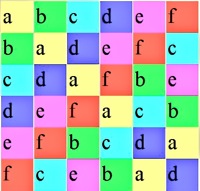Difference between revisions of "Associativity"
m (Text replacement - "http://" to "https://") |
|||
| Line 1: | Line 1: | ||
[[File:lighterstill.jpg]][[File:Associativity_colors.jpg|right|frame]] | [[File:lighterstill.jpg]][[File:Associativity_colors.jpg|right|frame]] | ||
| − | In [[mathematics]], '''associativity''' is a property of some [ | + | In [[mathematics]], '''associativity''' is a property of some [https://en.wikipedia.org/wiki/Binary_operation binary operations]. It means that, within an [[expression]] containing two or more occurrences in a row of the same associative operator, the order in which the operations are [[performed]] does not matter as long as the [[sequence]] of the [https://en.wikipedia.org/wiki/Operand operands] is not changed. That is, rearranging the parentheses in such an expression will not [[change]] its [[value]]. Consider for instance the [[equation]] |
[[File:Associativity1.jpg]] | [[File:Associativity1.jpg]] | ||
| − | Even though the parentheses were rearranged (the left side requires adding 5 and 2 first, then adding 1 to the result, whereas the right side requires adding 2 and 1 first, then 5), the [[value]] of the [[expression]] was not [[Change|altered]]. Since this holds true when [[performing]] addition on any [ | + | Even though the parentheses were rearranged (the left side requires adding 5 and 2 first, then adding 1 to the result, whereas the right side requires adding 2 and 1 first, then 5), the [[value]] of the [[expression]] was not [[Change|altered]]. Since this holds true when [[performing]] addition on any [https://en.wikipedia.org/wiki/Real_number real numbers], we say that "addition of real numbers is an associative operation." |
| − | Associativity is not to be confused with [ | + | Associativity is not to be confused with [https://en.wikipedia.org/wiki/Commutativity commutativity]. Commutativity justifies changing the order or [[sequence]] of the operands within an expression while associativity does not. For example, |
[[File:Associativity2.jpg]] | [[File:Associativity2.jpg]] | ||
| Line 17: | Line 17: | ||
is not an example of associativity because the operand sequence changed when the 2 and 5 switched places. | is not an example of associativity because the operand sequence changed when the 2 and 5 switched places. | ||
| − | Associative operations are [[abundant]] in [[mathematics]]; in [[fact]], many [ | + | Associative operations are [[abundant]] in [[mathematics]]; in [[fact]], many [https://en.wikipedia.org/wiki/Algebraic_structure algebraic structures] (such as [https://en.wikipedia.org/wiki/Semigroup_(mathematics) semigroups] and categories) explicitly require their binary operations to be associative. |
| − | However, many important and interesting operations are non-associative; one common example would be the [ | + | However, many important and interesting operations are non-associative; one common example would be the [https://en.wikipedia.org/wiki/Vector_cross_product vector cross product].[https://en.wikipedia.org/wiki/Associativity] |
==See also== | ==See also== | ||
*[[Association]] | *[[Association]] | ||
==References== | ==References== | ||
| − | # Dudek, W.A. (2001), "On some old problems in n-ary groups", Quasigroups and Related Systems 8: 15–36, | + | # Dudek, W.A. (2001), "On some old problems in n-ary groups", Quasigroups and Related Systems 8: 15–36, https://www.quasigroups.eu/contents/contents8.php?m=trzeci . |
[[Category: Mathematics]] | [[Category: Mathematics]] | ||
Latest revision as of 23:42, 12 December 2020
In mathematics, associativity is a property of some binary operations. It means that, within an expression containing two or more occurrences in a row of the same associative operator, the order in which the operations are performed does not matter as long as the sequence of the operands is not changed. That is, rearranging the parentheses in such an expression will not change its value. Consider for instance the equation
Even though the parentheses were rearranged (the left side requires adding 5 and 2 first, then adding 1 to the result, whereas the right side requires adding 2 and 1 first, then 5), the value of the expression was not altered. Since this holds true when performing addition on any real numbers, we say that "addition of real numbers is an associative operation."
Associativity is not to be confused with commutativity. Commutativity justifies changing the order or sequence of the operands within an expression while associativity does not. For example,
is an example of associativity because the parentheses were changed (and consequently the order of operations during evaluation) while the operands 5, 2, and 1 appeared in the exact same order from left to right in the expression.
is not an example of associativity because the operand sequence changed when the 2 and 5 switched places.
Associative operations are abundant in mathematics; in fact, many algebraic structures (such as semigroups and categories) explicitly require their binary operations to be associative.
However, many important and interesting operations are non-associative; one common example would be the vector cross product.[1]
See also
References
- Dudek, W.A. (2001), "On some old problems in n-ary groups", Quasigroups and Related Systems 8: 15–36, https://www.quasigroups.eu/contents/contents8.php?m=trzeci .
